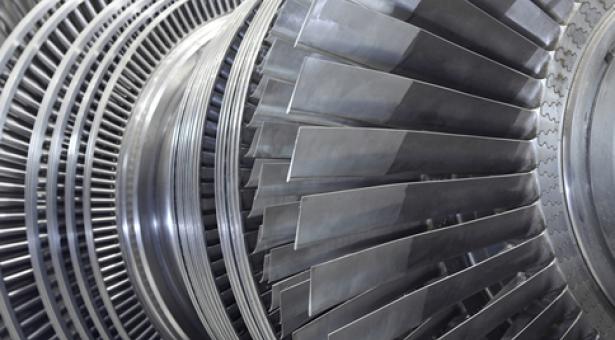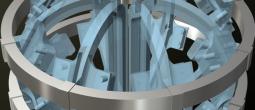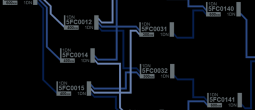

power generation sub-system

The generation subsystem converts thermal energy (in the form of pressurised steam) to mechanical energy power by a turbine assembly which is then converted to electrical energy using an alternator assembly. The output of the alternator assembly is high-frequency AC power which is distributed by the Power Distribution Network (PDN).
The generation subsystem is schematically within secondary coolant loop, given that both intake and exhaust is provided by the secondary loop. However, functional distinctiveness makes it useful to treat power generation as a separate subsystem.
turbine
The generation turbine is a four-stage reaction assembly steam turbine. The reaction stage is comprised of four sets of alternated rotating and fixed blades encased in a pressure vessel. The inner-rotating blades are connected to the spinning turbine shaft, whereas the fixed blades (or stators) are connected to the outer pressure vessel casing and do not rotate.
Propellant (in the form of steam) enters the turbine via a narrow nozzle causing rapid expansion and a conversion of the high pressure of the propellant into steam velocity. It is the transfer of this kinetic energy from the propellant to the turbine blade which drives the turbine shaft, generating primary systems power.
As propellant flows past the aero-foil shaped inner rotating blades it causes a pressure differential across the blade, transferring the velocity of the coolant to the turbine shaft at the cost of propellant velocity. The first array of stators corrects this, redirecting and increasing the propellant’s velocity onto the next set of rotating blades. The inward curving shape and angle of the stators compresses the propellant as it passes. On exiting the stator the propellant once again expands, causing an overall drop in enthalpy (thermal energy) but an equivalent increase in velocity. In this way the propellant is continually compressed and decompressed as it moves through the turbine stages, converting the maximum percentage of the propellant’s enthalpy into kinetic energy. The turbine's exhaust temperature is therefore significantly lowered across the turbine.
turbine tuning
The turbine must provide the alternator with a constant rate of revolutions in order to ensure the output of AC power with a consistent frequency. As the combined effect of work done by the coolant on each stage of the turbine correlates with the rotational speed of the turbine, the surface area presented by the of the inner rotating blades is variable by adjusting their angle of attack, allowing the turbine to operate efficiently across a variable range of coolant velocities.
The optimal angle of attack (OAA) for each set of reaction rotor blades is dependent on the current steam velocity at that stage of the assembly. An OAA which is too steep will interrupt the flow of high velocity coolant causing an increase in pressure and decrease in coolant velocity. Where the current OAA is too low, the efficiency of the transfer of the coolant's kinetic energy to the rotor blades decreases due to an equalization in pressure differential across the high-pressure and low pressure sides of the aero-foil shaped inner blades.
alternator
The alternator assembly uses the turbine to produce electrical power. The turbine turns a rotating magnet (rotor) within a stationery set of wound conductors (stator) to produce AC power. The rotating magnetic field induces an AC voltage in the stator windings. The rotor’s magnetic field is generated by a field coil electromagnet, which allows the generator’s output voltage to controlled by varying the current sent through the rotor’s field coil. In this way, a drop in generation voltage caused by demand can be compensated for by increasing power to the field coil.
Once cycle of alternating current is produced each time a pair of magnetic field poles passes over a point in the stator windings. The frequency of AC power generated must be constant for consumption by vessel systems, which requires that the rotor is turned at a constant frequency. The alternator is a twelve-pole assembly producing 400Hz and so requires a constant 4,000 RPM from the turbine.








